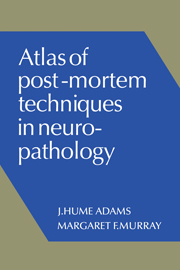1 - The Brain
Published online by Cambridge University Press: 21 May 2010
Summary
Before commencing a post–mortem examination on any patient known to have had some neurological disease, the pathologist must consider – preferably in consultation with the clinician – what special steps might have to be undertaken prior to fixing the brain. If there is any clinical suspicion of meningitis, some of the exudate should be sent for bacteriological examination – micro–biologists prefer exudate itself rather than a swab; if any type of encephalitis has been considered in the differential diagnosis, representative samples of brain tissue should be placed in an appropriate transport medium and sent for virological examination – and also samples of blood and cerebrospinal fluid for serological studies; if there is a possibility of some lysosomal enzyme deficiency, e.g. one of the neuronal storage disorders, or an unusual type of demyelinating disease, some brain tissue should be deep frozen as quickly as possible in case it is required later for neurochemical analysis; and if the post–mortem examination is being undertaken soon after death, the possibility of taking samples of the brain for electron microscopy should be borne in mind.
There are two basic principles in removing the brain – all structures holding it in position must be cut without inflicting any damage on the brain, and undue stretching of the brain stem must be avoided since it is very liable to tear at the level of the midbrain (see Fig. 1.26).
- Type
- Chapter
- Information
- Atlas of Post-Mortem Techniques in Neuropathology , pp. 1 - 33Publisher: Cambridge University PressPrint publication year: 1982



